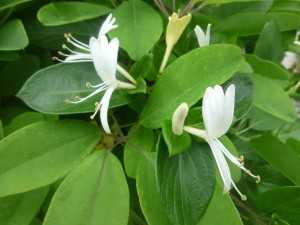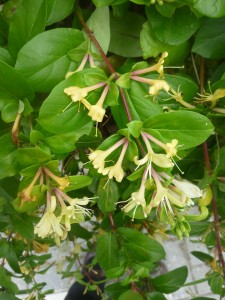Storytelling Starters ~ Encapsulating honeysuckle
 I wish I could encapsulate the honeysuckle growing in the next street from me and somehow include it in this blog so you could smell it as you read. Maybe some day that’ll become possible. Meantime Iron-Age forts have been on my mind.
I wish I could encapsulate the honeysuckle growing in the next street from me and somehow include it in this blog so you could smell it as you read. Maybe some day that’ll become possible. Meantime Iron-Age forts have been on my mind.
Why Iron-Age forts? Because next Monday I’m doing some storytelling training for guides at Castell Henllys, the Iron-Age fort in North Pembrokeshire. It’s the only such place which today has roundhouses on the exact site of the ones that were there back then.
The length of time:
What strikes me, thinking about that long-ago time is the very length of the time from then to now. And how can you possibly get that across? Almost as hard as electronically encapsulating the honeysuckle, the challenge reminds me of how I once had to try to make a class of 10-year old Stevenage children conscious of Ancient Egypt at the same time as taking into account their other current project – Ourselves Now.
Miraculously – for the results were fantastic – I got the idea of giving the children some sense of the passage of time by coming up with memories from each year of their lives and then creating hieroglyphs to represent them like the hieroglyphs from Ancient Egypt they’d already been learning about. This led on to them making memory charts and this then led to them telling their personal stories and deciding (this was entirely their own idea!) to punctuate each of the 10 years for which they had stories with the sound of a gong.
What the Iron-Age had:
The Iron-Age began a long time ago – about 2,500 years in fact. Strongest in my mind when thinking about it has been what people had at the time and, equally, what they didn’t have. No central heating. No telephones. No piped water. No electric or gas ovens. No TVs. No books. No computers. No blogs.
What they did have was the elements – Earth, Air, Fire, Water.
 They also had what could be made by linking the elements with each other. Water gives something to drink but also something that can be used to mix clay to create building materials. Fire gives heat and something to cook with but also it produces smoke which keeps insects from breeding in the roof of the house. And so on.
They also had what could be made by linking the elements with each other. Water gives something to drink but also something that can be used to mix clay to create building materials. Fire gives heat and something to cook with but also it produces smoke which keeps insects from breeding in the roof of the house. And so on.
Thinking about the elements also prompted me to remember that excellent chant which sounds great when there’s a whole bunch of people to sing it. Here it is and, alternate lines, my Welsh translation of it.
Tall trees, deep water
Pren tal, dwr dwfn
Strong winds, warm fire.
Gwynt cryf, tân cynnes.
I feel it in my body
Rwy’n eu teimlo yn fy nghorff i
And I feel it in my heart.
Rwy’n eu teimlo yn fy nghalon.
To hear my tune for this chant, please click below.
Boom! Boom! Boom!
See you next week.
Tags: 10-year olds, Castell Henllys, chant, honeysuckle, Iron-Age fort, Pembrokeshire, Stevenage



June 27th, 2015 at 11:02 am
Interesting blog as always, Mary, thank you. I was just thinking that one very important thing that the Iron Age people had, and that we in 21st Century also have, is that they had each other.
June 30th, 2015 at 12:00 pm
Dear Karen, Lovely to hear from you. And what you said made me really stop and appreciate how important other people must have been in that distant Iron-Age past when there wouldn’t have been many other people around. Oddly, I was reminded of my father’s parents on their smallholding in the middle of the North Pembrokeshire countryside – a very small community and very faithful friends.
June 27th, 2015 at 11:30 am
More gold – Thank you again and for the golden song of Mary – ah technology. xx
June 30th, 2015 at 11:55 am
More songs in future, I hope. A new world opens up!
June 27th, 2015 at 2:21 pm
Lovely blog as always, Your mention here of honeysuckle reminds me of my dear Mum, it was one of her favourite, As a child her Mum use to pick it and bring in the house, Thank you always for your interesting blogs every week, xx Liz
June 30th, 2015 at 11:54 am
Great to hear from you as always. It’s lovely that your Mum loved honeysuckle. The smell always stops me in my tracks when I’m walking along. Then I have to pause to have a proper sniff.
June 28th, 2015 at 10:21 am
What a coincidence, Mary. We have just returned from the Isle of Lewis. In 1996 archeologists excavated an entire Iron Age village on the beach on the small island of Great Bernera. The village has been reburied to protect it, but one of the houses has been reconstructed nearby and a wonderful woman called Elizabeth Macleod sits inside for four hours a day, tending the peat fire and explaining to visitors how life might have been in the Iron Age for the people who inhabited these houses. The interior is very dark and smoky until your eyes adjust, and one can just imagine the singing and the storytelling that took place on dark evenings around the fire. Magical!
June 30th, 2015 at 11:51 am
Dear Hilary, a coincidence indeed. Castell Henllys is a small village with a reconstructed forge and cookhouse as well as three roundhouses, all very atmospheric. The fires inside the huts were not alight yesterday but the lingering smell of smoke was very evocative. I liked the darkness inside the huts too. The location is stunningly beaufiful. On the Carn Ingli, the hill you can see in the distance, there apparently were 29 roundhouses – quite a metropolis.